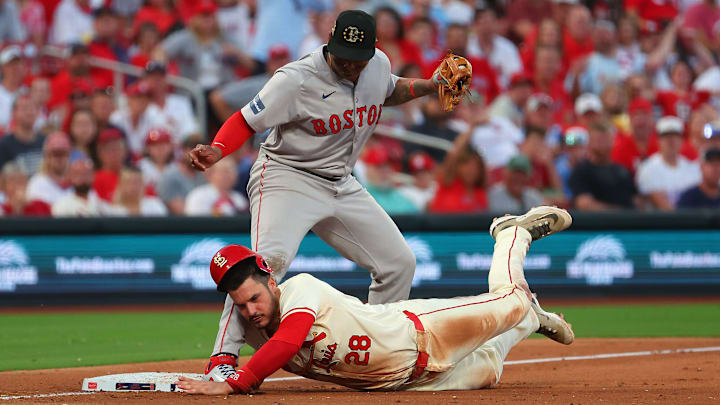When the St. Louis Cardinals acquired superstar third baseman Nolan Arenado from the Colorado Rockies, it immediately looked like a lopsided trade. After seeing what the Boston Red Sox got for parting with Rafael Devers, that deal looks even better.
While I've seen many fans shocked at how little it seems the Red Sox got in return for Devers, I'd actually argue that's fair value for a player with Devers' profile, his age, his poor defense and long-term 1B/DH profile, as well as the massive contract he is signed to. Altogether, Devers is not the kind of player who is going to bring back a flashy return, and the fact that Boston actually got useful pieces for him and gave away the entire contract makes the Cardinals' deal back in 2021 look like highway robbery.
If this is what the Red Sox were able to get for Rafael Devers, the Cardinals got away with highway robbery in the Nolan Arenado trade.
No one was arguing (or at least, no one should have been arguing) that the Arenado trade wasn't a great deal for St. Louis, but now having another case study to compare it to, it makes the deal even more mind-boggling.
Let's recap the two trades real quick so I can explain why I believe the Red Sox made out as good as you can for trading away an elite bat on a megadeal, and why the Cardinals' deal for Arenado just looks even better.
The Red Sox acquired LHP Kyle Harrison, RHP Jordan Hicks, OF James Tibbs III, and RHP Jose Bello in return for Rafael Devers and the rest of this year's $29.5 million he is owed, as well as the remaining eight years, $254.5 million he is owed.
Harrison, prior to the 2024 season, was Baseball America's 30th-ranked prospect in all of baseball and has five years of control remaining. While he has not been great to start his big league career, his fastball velocity is up multiple ticks in 2025, and his K% is up by a few percentage points as well. Tibbs was the 13th overall pick in the 2024 MLB Draft and shows a lot of promise as a prospect. Jordan Hicks is due $12.5 million this year and each of the next two seasons, and while he has struggled as a starter, he could still provide Boston value there or become a high-leverage reliever. Bello was not ranked in the Giants' top 30 prospects according to Baseball America.
While that is not some flashy return, it does give Boston pieces to work with moving forward, and Harrison provides them legit upside for a cost-controlled impact starter. Hicks' deal is very team-friendly if he can be a viable starter and about market value for a reliever, and Tibbs could become a valuable piece for them down the line.
All in all, Boston frees up $17 million in the immediate future while they are paying Hicks and north of $30 million a year after 2027 as Devers' contract creeps up in annual value. It's on Boston to utilize that financial flexibility to add to the roster, or it makes the trade a lot harder to swallow. Obviously, the performance of both Devers and the pieces they got back will matter. If Devers plays like a top-15 bat for years to come, his contract ages well, and it's hard to imagine letting go of him. But if he regresses, and/or guys like Harrison or Hicks produce, then the Red Sox may look pretty foolish later on.
Compare that to the Cardinals, who gave up LHP Austin Gomber, RHP Tony Locey, 1B Elehuris Montero, 3B Mateo Gil, and RHP Jake Sommers in exchange for Nolan Arenado and $51 million in cash, which put the Cardinals on the hook for just $148 million over the six-year contract.
Uh, yeah, that's an incredible deal for the Cardinals when you compare the two.
Yes, Arenado was going into his age-30 season (Devers is still 28) and had shown signs of regression offensively, but he was still an all-time defender at third base and ended up having multiple good offensive campaigns for St. Louis, including a third-place finish in MVP voting in 2022. The Cardinals owed Arenado an average of $24.6 million per season, and the players they gave up to get them were practically worthless.
Montero was a -2.6 fWAR player for Colorado, while Gomber provided about 4.6 fWAR as a cheap, mediocre starter for them. Locey, Gil, and Sommers never made it to the big leagues.
Looking at this today, I can't help but be reminded of how incredible of a trade this way by John Mozeliak at the time, and if Devers ends up regressing as a player offensively, he'll become an even more negative asset than Areando feels right now. Plus, Harrison, Hicks, and Tibbs could provide real value for the Red Sox moving forward, plus the freed-up cash flow they now have.
Honestly, I would have traded for Devers if I were running the Cardinals, and I'll have a piece up on that later today. I'll explain all of my thoughts there, but for now, I wanted to just compare these two deals, as I find it to be a fascinating comparison.
